Second-harmonic generation
Second-harmonic generation (SHG, also called frequency doubling) is a nonlinear optical process in which two photons with the same frequency interact with a nonlinear material, are "combined", and generate a new photon with twice the energy of the initial photons (equivalently, twice the frequency and half the wavelength), that conserves the coherence of the excitation. It is a special case of sum-frequency generation (2 photons), and more generally of harmonic generation.
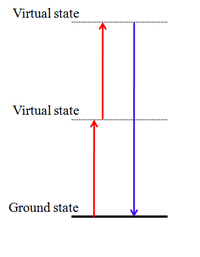
The second-order nonlinear susceptibility of a medium characterizes its tendency to cause SHG. Second-harmonic generation, like other even-order nonlinear optical phenomena, is not allowed in media with inversion symmetry.[1] However, effects such as the Bloch–Siegert shift (oscillation), found when two-level systems are driven at Rabi frequencies comparable to their transition frequencies, will give rise to second harmonic generation in centro-symmetric systems. [2] [3]
In some cases, almost 100% of the light energy can be converted to the second harmonic frequency. These cases typically involve intense pulsed laser beams passing through large crystals, and careful alignment to obtain phase matching. In other cases, like second-harmonic imaging microscopy, only a tiny fraction of the light energy is converted to the second harmonic—but this light can nevertheless be detected with the help of optical filters.

Generating the second harmonic, often called frequency doubling, is also a process in radio communication; it was developed early in the 20th century, and has been used with frequencies in the megahertz range. It is a special case of frequency multiplication.
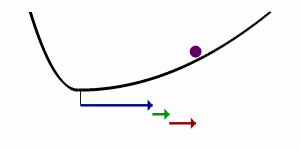
History
Second-harmonic generation was first demonstrated by Peter Franken, A. E. Hill, C. W. Peters, and G. Weinreich at the University of Michigan, Ann Arbor, in 1961.[4] The demonstration was made possible by the invention of the laser, which created the required high intensity coherent light. They focused a ruby laser with a wavelength of 694 nm into a quartz sample. They sent the output light through a spectrometer, recording the spectrum on photographic paper, which indicated the production of light at 347 nm. Famously, when published in the journal Physical Review Letters,[4] the copy editor mistook the dim spot (at 347 nm) on the photographic paper as a speck of dirt and removed it from the publication.[5] The formulation of SHG was initially described by N. Bloembergen and P. S. Pershan at Harvard in 1962.[6] In their extensive evaluation of Maxwell's equations at the planar interface between a linear and nonlinear medium, several rules for the interaction of light in non-linear mediums were elucidated.
Types in crystals
Critical phase-matching
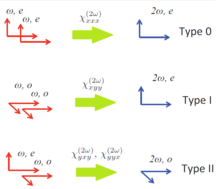
Second-harmonic generation occurs in three types for critical phase-matching,[7] denoted 0, I and II. In Type 0 SHG two photons having extraordinary polarization with respect to the crystal will combine to form a single photon with double the frequency/energy and extraordinary polarization. In Type I SHG two photons having ordinary polarization with respect to the crystal will combine to form one photon with double the frequency and extraordinary polarization. In Type II SHG, two photons having orthogonal polarizations will combine to form one photon with double the frequency and ordinary polarization. For a given crystal orientation, only one of these types of SHG occurs. In general to utilise Type 0 interactions a quasi-phase-matching crystal type will be required, for example periodically poled lithium niobate (PPLN).

Non-critical phase-matching
Since phase-matching process basically means to adapt the optical indices n at ω and 2ω, it can also be done by a temperature control in some birefringent crystals, because n changes with the temperature. For instance, LBO presents a perfect phase-matching at 25 °C for a SHG excited at 1200 or 1400 nm,[8] but needs to be elevated at 200 °C for SHG with the usual laser line of 1064 nm. It is called "non-critical" because it does not depends on the crystal orientation as usual phase-matching.
Optical second-harmonic generation
Since media with inversion symmetry are forbidden from generating second-harmonic light (unlike third harmonic generation), surfaces and interfaces make interesting subjects for study with SHG. In fact, second-harmonic generation and sum frequency generation discriminate against signals from the bulk, implicitly labeling them as surface specific techniques. In 1982, T. F. Heinz and Y. R. Shen explicitly demonstrated for the first time that SHG could be used as a spectroscopic technique to probe molecular monolayers adsorbed to surfaces.[9] Heinz and Shen adsorbed monolayers of laser dye rhodamine to a planar fused silica surface; the coated surface was then pumped by a nanosecond ultra-fast laser. SH light with characteristic spectra of the adsorbed molecule and its electronic transitions were measured as reflection from the surface and demonstrated a quadratic power dependence on the pump laser power.
In SHG spectroscopy, one focuses on measuring twice the incident frequency 2ω given an incoming electric field in order to reveal information about a surface. Simply (for a more in-depth derivation see below), the induced second-harmonic dipole per unit volume, , can be written as
where is known as the nonlinear susceptibility tensor and is a characteristic to the materials at the interface of study.[10] The generated and corresponding have been shown to reveal information about the orientation of molecules at a surface/interface, the interfacial analytical chemistry of surfaces, and chemical reactions at interfaces.
From planar surfaces
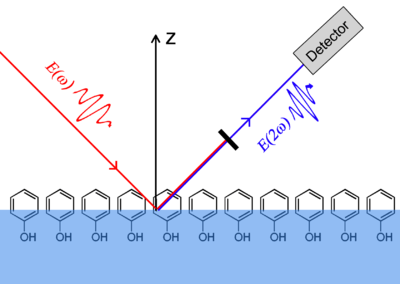
Early experiments in the field demonstrated second-harmonic generation from metal surfaces.[11] Eventually, SHG was used to probe the air-water interface, allowing for detailed information about molecular orientation and ordering at one of the most ubiquitous of surfaces.[12] It can be shown that the specific elements of :
where Ns is the adsorbate density, θ is the angle that the molecular axis z makes with the surface normal Z, and is the dominating element of the nonlinear polarizability of a molecule at an interface, allow one to determine θ, given laboratory coordinates (x, y, z).[13] Using an interference SHG method to determine these elements of χ(2), the first molecular orientation measurement showed that the hydroxyl group of phenol pointed downwards into the water at the air-water interface (as expected due to the potential of hydroxyl groups to form hydrogen bonds). Additionally SHG at planar surfaces has revealed differences in pKa and rotational motions of molecules at interfaces.
From non-planar surfaces
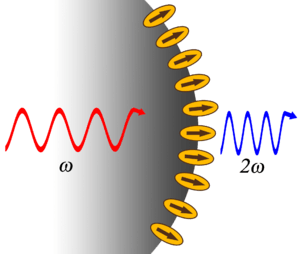
Second-harmonic light can also be generated from surfaces that are ‘locally’ planar, but may have inversion symmetry (centrosymmetric) on a larger scale. Specifically, recent theory has demonstrated that SHG from small spherical particles (micro- and nanometer scale) is allowed by proper treatment of Rayleigh scattering.[14] At the surface of a small sphere, inversion symmetry is broken, allowing for SHG and other even order harmonics to occur.
For a colloidal system of microparticles at relatively low concentrations, the total SH signal , is given by:
where is the SH electric field generated by the jth particle, and n the density of particles.[15] The SH light generated from each particle is coherent, but adds incoherently to the SH light generated by others (as long as density is low enough). Thus, SH light is only generated from the interfaces of the spheres and their environment and is independent of particle-particle interactions. It has also been shown that the second-harmonic electric field scales with the radius of the particle cubed, a3.
Besides spheres, other small particles like rods have been studied similarly by SHG.[16] Both immobilized and colloidal systems of small particles can be investigated. Recent experiments using second-harmonic generation of non-planar systems include transport kinetics across living cell membranes[17] and demonstrations of SHG in complex nanomaterials.[18]
Radiation pattern
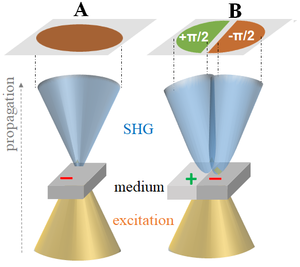
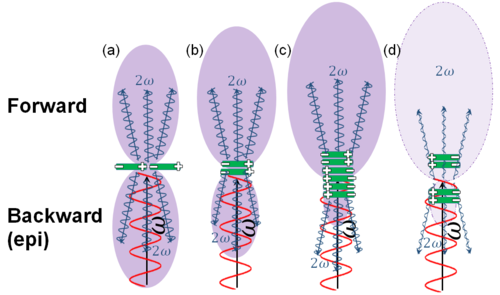
The SHG radiation pattern generated by an exciting Gaussian beam also has a (homogeneous) 2D Gaussian profile if the nonlinear medium being excited is homogeneous (A). However, if the exciting beam is positioned at an interface between opposite polarities (+/- boundary, B) that is parallel to the beam propagation (see figure), the SHG will be split into two lobes whose amplitudes have opposite sign, i.e. are phase-shifted. [19]
These boundaries can be found in the sarcomeres of muscles (protein = myosin), for instance. Note that we have considered here only the forward generation.
Moreover the SHG phase-matching can also result in : some SHG is also emitted in backward (epi direction). When the phase-matching is not fulfilled, as in biological tissues, the backward signal comes from a sufficiently high phase-mismatch which allow a small backward contribution to compensate for it.[20] Unlike fluorescence, the spatial coherence of the process constrain it to emit only in those two directions, but the coherence length in backward is always way smaller than in forward, meaning there is always more forward than backward SHG signal.[21]
The forward (F) to backward (B) ratio is dependent on the arrangement of the different dipoles (green in figure) that are being excited. With only one dipole ((a) in the figure), F = B, but F becomes higher than B when more dipoles are stacked along the propagation direction (b and c). However, the Gouy phase-shift of the Gaussian beam will imply a phase-shift between the SHGs generated at the edges of the focal volume, and can thus result in destructive interferences (zero signal) if there are dipoles at these edges having the same orientation (case (d) in the figure).
Commercial uses
Second-harmonic generation is used by the laser industry to make green 532 nm lasers from a 1064 nm source. The 1064 nm light is fed through a bulk KDP crystal. In high-quality diode lasers the crystal is coated on the output side with an infrared filter to prevent leakage of intense 1064 nm or 808 nm infrared light into the beam. Both of these wavelengths are invisible and do not trigger the defensive "blink-reflex" reaction in the eye and can therefore be a special hazard to the human eyes. Furthermore, some laser safety eyewear intended for argon or other green lasers may filter out the green component (giving a false sense of safety), but transmit the infrared. Nevertheless, some "green laser pointer" products have become available on the market which omit the expensive infrared filter, often without warning.[22] Second-harmonic generation is also used for measuring ultra short pulse width with autocorrelators.
Other applications
Ultra-short pulse measurement
Characterizing an ultrashort pulse (like measuring its temporal width) cannot be done directly with electronics only, as the time-scale is below 1ps (sec) : it needs to use the pulse itself, that is why an autocorrelation function is often used. SHG has the advantage of mixing two input fields to generate the harmonic one, it is thus a good candidate (but not the only one) to perform such a pulse measurement. Optical autocorrelation, in its intensity or fringe-resolved (interferometric) version use SHG,[23] unlike field autocorrelation. Also, most versions of the FROG (called SHG-FROG) use SHG to mix the delayed fields.[24]
Second-harmonic generation microscopy
In biological and medical science, the effect of second-harmonic generation is used for high-resolution optical microscopy. Because of the non-zero second-harmonic coefficient, only non-centrosymmetric structures are capable of emitting SHG light. One such structure is collagen, which is found in most load-bearing tissues. Using a short-pulse laser such as a femtosecond laser and a set of appropriate filters the excitation light can be easily separated from the emitted, frequency-doubled SHG signal. This allows for very high axial and lateral resolution comparable to that of confocal microscopy without having to use pinholes. SHG microscopy has been used for studies of the cornea[25] and lamina cribrosa sclerae,[26] both of which consist primarily of collagen. Second-harmonic generation can be produced by several non-centrosymmetric organic dyes; however, most of the organic dyes also generate collateral fluorescence along with second-harmonic generation signals.[27] Until now, only two classes of organic dyes have been shown which do not produce any collateral fluorescence and works purely on second-harmonic generation.[27][28] Recently, using two-photon excited fluorescence and second-harmonic generation-based microscopy, a group of Oxford University researchers showed that organic porphyrin-type molecules can have different transition dipole moments for two-photon fluorescence and second-harmonic generation,[29] which are otherwise thought to occur from the same transition dipole moment.[30]
Second-harmonic generation microscopy is also used in material science, for instance to characterize nanostructured materials.[31]
Theoretical derivation (plane wave)
At low conversion
The simplest case for analysis of second-harmonic generation is a plane wave of amplitude E(ω) traveling in a nonlinear medium in the direction of its k vector. A polarization is generated at the second-harmonic frequency:[32]
where is the effective nonlinear optical coefficient which is dependent on specific components of that are involved in this particular interaction. The wave equation at 2ω (assuming negligible loss and asserting the slowly varying envelope approximation) is
where .
At low conversion efficiency (E(2ω) ≪ E(ω)) the amplitude remains essentially constant over the interaction length, . Then, with the boundary condition we obtain
In terms of the optical intensity, , this is,
This intensity is maximized for the phase-matched condition Δk = 0. If the process is not phase matched, the driving polarization at ω goes in and out of phase with generated wave E(2ω) and conversion oscillates as sin(Δkl/2). The coherence length is defined as . It does not pay to use a nonlinear crystal much longer than the coherence length. (Periodic poling and quasi-phase-matching provide another approach to this problem.)
With depletion
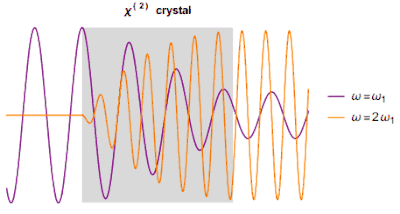
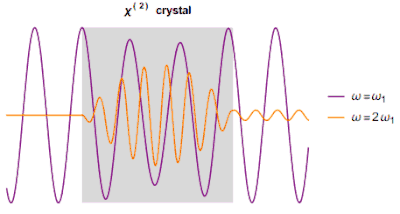
When the conversion to 2nd harmonic becomes significant it becomes necessary to include depletion of the fundamental. The energy conversion states that all the involved fields verify the Manley–Rowe relations. One then has the coupled equations:[33]
where denotes the complex conjugate. For simplicity, assume phase matched generation (). Then, energy conservation requires that
where is the complex conjugate of the other term, or
- .
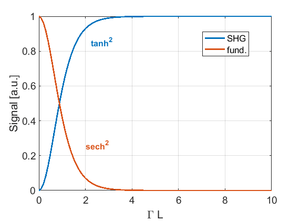
Now we solve the equations with the premise
and obtain
which leads to:
Using
we get
If we assume a real , the relative phases for real harmonic growth must be such that . Then
or
where . From , it also follows that
Theoretical expression with Gaussian beams
The excitation wave is assumed to be a Gaussian beam, of amplitude:
with , the direction of propagation, the Rayleigh range, the wave vector.
Each wave verifies the wave equation:
where .
With phase-matching
It can be shown that:
(a Gaussian), is a solution of the equation (n=2 for SHG).
No phase-matching
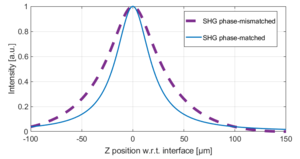
A non-perfect phase-matching is a more realistic condition in practice, especially in biological samples. The paraxial approximation is however supposed still valid: , and in the harmonic expression, is now .
In the special case of SHG (n=2), in a medium of length L and a focus position , the intensity writes:[34] .
where is the speed of light in vacuum, the vacuum permittivity, the optical index of the medium at and the waist size of excitation.
Thus, the SHG intensity quickly decays in the bulk (), due to the Gouy phase-shift of the Gaussian beam.
In conformity with experiments, the SHG signal vanishes in the bulk (if the medium thickness is too large), and the SHG must be generated at the surface of the material: the conversion therefore does not strictly scales with the square of the number of scatterers, contrary to what the plane wave model indicates. Interestingly, the signal also vanishes in bulk for higher orders, like THG.
Materials used for second-harmonic generation
Materials capable of generating a second harmonic are crystals without inversion symmetry. This eliminates water, cubic symmetry crystals and glass.[32]
Here are some crystals used with certain types of laser for SHG conversion:
- Fundamental excitation at 600–1500 nm:[35] BiBO (BiB3O6)
- Fundamental excitation at 570–4000 nm:[36] Lithium iodate LiIO3.
- Fundamental excitation at 800–1100, often 860 or 980 nm:[37] Potassium niobate KNbO3
- Fundamental excitation at 410–2000 nm : BBO (β-BaB2O4)[38]
- Fundamental excitation at 984 nm–3400 nm: KTP (KTiOPO4) or KTA,[39]
- Fundamental excitation at 1 064 nm : monopotassium phosphate KDP (KH2PO4), lithium triborate (LiB3O5), CsLiB6O10 and Barium borate BBO(β-BaB2O4).
- Fundamental excitation at 1 319 nm : KNbO3, BBO (β-BaB2O4), monopotassium phosphate KDP (KH2PO4), LiIO3, LiNbO3, and potassium titanyl phosphate KTP (KTiOPO4).
- Fundamental excitation at ~1000-2000 nm : periodically-poled crystals, like PPLN.[40]
Notably, filamentous biological proteins with a cylindrical symmetric such as collagen, tubulin or myosin, but also certain carbohydrates (such as starch or cellulose) are also quite good converters of SHG (fundamental in the near infrared).[41]
See also
References
- Boyd, R. (2007). "The Nonlinear Optical Susceptibility". Nonlinear optics (third edition). pp. 1–67. doi:10.1016/B978-0-12-369470-6.00001-0. ISBN 9780123694706.
- Cardoso, G.C.; Pradhan, P.; Morzinski, J.; Shahriar, M.S. (2005). "In situ detection of the temporal and initial phase of the second harmonic of a microwave field via incoherent fluorescence". Physical Review A. 71 (6): 063408. arXiv:quant-ph/0410219. doi:10.1103/PhysRevA.71.063408.
- Pradhan, P.; Cardoso, G.C.; Shahriar, M.S. (2009). "Suppression of error in qubit rotations due to Bloch–Siegert oscillation via the use of off-resonant Raman excitation". Journal of Physics B: Atomic, Molecular and Optical Physics. 42 (6): 065501. doi:10.1088/0953-4075/42/6/065501.
- Franken, P.; Hill, A.; Peters, C.; Weinreich, G. (1961). "Generation of Optical Harmonics". Physical Review Letters. 7 (4): 118–119. Bibcode:1961PhRvL...7..118F. doi:10.1103/PhysRevLett.7.118.
- Haroche, Serge (October 17, 2008). "Essay: Fifty Years of Atomic, Molecular and Optical Physics in Physical Review Letters". Physical Review Letters. 101 (16): 160001. Bibcode:2008PhRvL.101p0001H. doi:10.1103/PhysRevLett.101.160001. PMID 18999650.
- Bloembergen, N.; Pershan, P. S. (1962). "Light Waves at Boundary of Nonlinear Media" (PDF). Physical Review. 128 (2): 606–622. Bibcode:1962PhRv..128..606B. doi:10.1103/PhysRev.128.606. hdl:1874/7432.
- "Critical phase-matching". rp-photonics.com. Retrieved 2019-11-01.
- "Noncritical phase-matching". rp-photonics.com. Retrieved 2019-11-01.
- Heinz, T. F.; et al. (1982). "Spectroscopy of Molecular Monolayers by Resonant 2nd-Harmonic Generation". Physical Review Letters. 48 (7): 478–81. Bibcode:1982PhRvL..48..478H. doi:10.1103/PhysRevLett.48.478.
- Shen, Y. R. (1989). "Surface-Properties Probed by 2nd-Harmonic and Sum-Frequency Generation". Nature. 337 (6207): 519–25. Bibcode:1989Natur.337..519S. doi:10.1038/337519a0.
- Brown, F.; Matsuoka, M. (1969). "Effect of Adsorbed Surface Layers on Second-Harmonic Light from Silver". Physical Review. 185 (3): 985–987. Bibcode:1969PhRv..185..985B. doi:10.1103/PhysRev.185.985.
- Eisenthal, K. B. (1992). "Equilibrium and Dynamic Processes at Interfaces by 2nd Harmonic and Sum Frequency Generation". Annual Review of Physical Chemistry. 43 (1): 627–61. doi:10.1146/annurev.physchem.43.1.627.
- Kemnitz, K.; et al. (1986). "The Phase of 2nd-Harmonic Light Generated at an Interface and Its Relation to Absolute Molecular-Orientation". Chemical Physics Letters. 131 (4–5): 285–90. Bibcode:1986CPL...131..285K. CiteSeerX 10.1.1.549.6666. doi:10.1016/0009-2614(86)87152-4.
- Dadap, J. I.; Shan, J.; Heinz, T. F. (2004). "Theory of Optical Second-Harmonic Generation from a Sphere of Centrosymmetric Material: Small-Particle Limit". Journal of the Optical Society of America B. 21 (7): 1328–47. Bibcode:2004JOSAB..21.1328D. doi:10.1364/JOSAB.21.001328.
- Eisenthal, K. B. (2006). "Second Harmonic Spectroscopy of Aqueous Nano- and Microparticle Interfaces". Chemical Reviews. 106 (4): 1462–77. doi:10.1021/cr0403685. PMID 16608187.
- Chan, S. W.; et al. (2006). "Second Harmonic Generation in Zinc Oxide Nanorods". Applied Physics B: Lasers and Optics. 84 (1–2): 351–55. Bibcode:2006ApPhB..84..351C. doi:10.1007/s00340-006-2292-0.
- Zeng, Jia; et al. (2013). "Time-Resolved Molecular Transport across Living Cell Membranes". Biophysical Journal. 104 (1): 139–45. Bibcode:2013BpJ...104..139Z. doi:10.1016/j.bpj.2012.11.3814. PMC 3540258. PMID 23332066.
- Fan, W.; et al. (2006). "Second Harmonic Generation from a Nanopatterned Isotropic Nonlinear Material". Nano Letters. 6 (5): 1027–30. Bibcode:2006NanoL...6.1027F. CiteSeerX 10.1.1.172.8506. doi:10.1021/nl0604457.
- Moreaux, Laurent; Sandre, Olivier; Charpak, Serge; Blanchard-Desce, Mireille; Mertz, Jerome (2001). "Coherent Scattering in Multi-Harmonic Light Microscopy". Biophysical Journal. 80 (3): 1568–1574. doi:10.1016/S0006-3495(01)76129-2. ISSN 0006-3495. PMC 1301348. PMID 11222317.
- Campagnola, Paul J; Loew, Leslie M (2003). "Second-harmonic imaging microscopy for visualizing biomolecular arrays in cells, tissues and organisms". Nature Biotechnology. pp. 1356–1360. doi:10.1038/nbt894. ISSN 1087-0156. Missing or empty
|url=(help) - LaComb, Ronald; Nadiarnykh, Oleg; Townsend, Sallie S.; Campagnola, Paul J. (2008). "Phase matching considerations in second harmonic generation from tissues: Effects on emission directionality, conversion efficiency and observed morphology". Optics Communications. 281 (7): 1823–1832. doi:10.1016/j.optcom.2007.10.040. ISSN 0030-4018. PMC 2390911.
- A warning about IR in green cheap green laser pointers
- Trebino, Rick; Zeek, Erik (2000). "Chap4, The Autocorrelation, the Spectrum, and Phase Retrieval". Frequency-Resolved Optical Gating: The Measurement of Ultrashort Laser Pulses. Springer. pp. 61–99. doi:10.1007/978-1-4615-1181-6_4. ISBN 978-1-4615-1181-6.
- Trebino, Rick (2003). "Chap5, FROG". Frequency-Resolved Optical Gating: The Measurement of Ultrashort Laser Pulses. Springer. pp. 61–99. doi:10.1007/978-1-4615-1181-6_5. ISBN 978-1-4615-1181-6.
- Han, M; Giese, G; Bille, J (2005). "Second harmonic generation imaging of collagen fibrils in cornea and sclera". Optics Express. 13 (15): 5791–7. Bibcode:2005OExpr..13.5791H. doi:10.1364/OPEX.13.005791. PMID 19498583.
- Brown, Donald J.; Morishige, Naoyuki; Neekhra, Aneesh; Minckler, Don S.; Jester, James V. (2007). "Application of second harmonic imaging microscopy to assess structural changes in optic nerve head structure ex vivo". Journal of Biomedical Optics. 12 (2): 024029. Bibcode:2007JBO....12b4029B. doi:10.1117/1.2717540. PMID 17477744.
- Khadria A, Fleischhauer J, Boczarow I, Wilkinson JD, Kohl MM, Anderson HL (2018). "Porphyrin Dyes for Nonlinear Optical Imaging of Live Cells". iScience - Cell Press. 4: 153–163. Bibcode:2018iSci....4..153K. doi:10.1016/j.isci.2018.05.015. PMC 6147020. PMID 30240737.
- Nuriya M, Fukushima S, Momotake A, Shinotsuka T, Yasui M, Arai T (2016). "Multimodal two-photon imaging using a second-harmonic generation-specific dye". Nature Communications. 7: 11557. Bibcode:2016NatCo...711557N. doi:10.1038/ncomms11557. PMC 4865818. PMID 27156702.
- Khadria A, Coene Y, Gawel P, Roche C, Clays K, Anderson HL (2017). "Push–pull pyropheophorbides for nonlinear optical imaging". Organic and Biomolecular Chemistry. 15 (4): 947–956. doi:10.1039/C6OB02319C. PMID 28054076.
- Reeve JE, Corbett AD, Boczarow I, Wilson T, Bayley H, Anderson HL (2012). "Probing the Orientational Distribution of Dyes in Membranes through Multiphoton Microscopy". Biophysical Journal. 103 (5): 907–917. Bibcode:2012BpJ...103..907R. doi:10.1016/j.bpj.2012.08.003. PMC 3433607. PMID 23009840.
- Valev, V. K. (2012). "Characterization of nanostructured plasmonic surfaces with second harmonic generation". Langmuir. 28 (44): 15454–15471. doi:10.1021/la302485c. PMID 22889193.
- Boyd, R.W. (2008). Nonlinear Optics, 3rd edition. ISBN 9780121216801.
- Zernike, Frits; Midwinter, John E. (1973). Applied Nonlinear Optics. John Wiley & Sons Inc. ISBN 0-486-45360-X.
- Stoller, Patrick; Celliers, Peter M.; Reiser, Karen M.; Rubenchik, Alexander M. (2003). "Quantitative second-harmonic generation microscopy in collagen". Applied Optics. 42 (25): 5209–19. doi:10.1364/AO.42.005209. ISSN 0003-6935. PMID 12962402.
- "BiBO Crystals". newlightphotonics.com. Retrieved 2019-11-01.
- "LiIO3 crystals - Lithium Iodate Crystal". shalomeo.com. Retrieved 2019-11-01.
- "KNbO3". laser-crylink.com. Retrieved 2019-11-01.
- "BBO Crystals". newlightphotonics.com. Retrieved 2019-11-01.
- "KTP Crystals". unitedcrystals.com. Retrieved 2019-11-01.
- Meyn, J.-P.; Laue, C.; Knappe, R.; Wallenstein, R.; Fejer, M.M. (2001). "Fabrication of periodically poled lithium tantalate for UV generation with diode lasers". Applied Physics B. 73 (2): 111–114. Bibcode:2001ApPhB..73..111M. doi:10.1007/s003400100623.
- Pavone, Francesco S.; Campagnola, Paul J. (2016). Second Harmonic Generation Imaging, 2nd edition. CRC Taylor&Francis. ISBN 978-1-4398-4914-9.
External links
Articles
- Parameswaran, K. R.; Kurz, J. R.; Roussev, M. M.; Fejer (2002). "Observation of 99% pump depletion in single-pass second-harmonic generation in a periodically poled lithium niobate waveguide". Optics Letters. 27 (1): 43–45. Bibcode:2002OptL...27...43P. doi:10.1364/ol.27.000043. PMID 18007710.
- "Frequency doubling". Encyclopedia of laser physics and technology. Retrieved 2006-11-04.